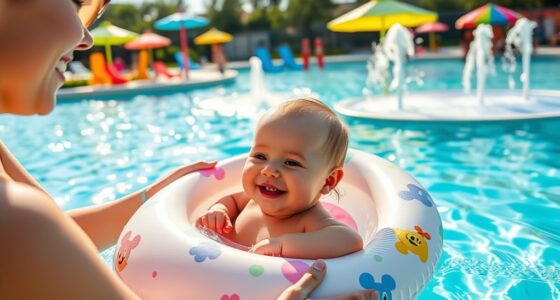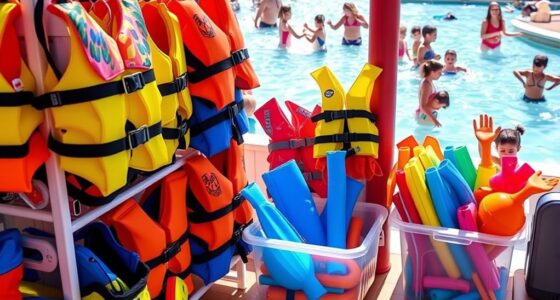Plan ahead by reviewing accessibility guides, renting mobility equipment, and reserving sensory-friendly spots. Choose calmer attractions and schedule breaks in quiet areas to prevent overstimulation. Use sensory tools like earplugs or weighted lap pads and keep an eye out for designated calm zones. Contact Guest Services early for personalized support and consider visiting during less busy hours. For more helpful tips to create a smooth, enjoyable experience, keep exploring these strategies.
Key Takeaways
- Visit during less crowded times and use guest services for personalized assistance.
- Identify and utilize quiet zones and shaded areas for sensory breaks.
- Bring sensory tools like noise-canceling headphones, sunglasses, and fidget toys for calming.
- Choose calmer attractions such as lazy rivers and water play areas with gentle features.
- Communicate special needs early and arrange for mobility devices and sensory-friendly accommodations.
Planning Your Visit With Accessibility in Mind
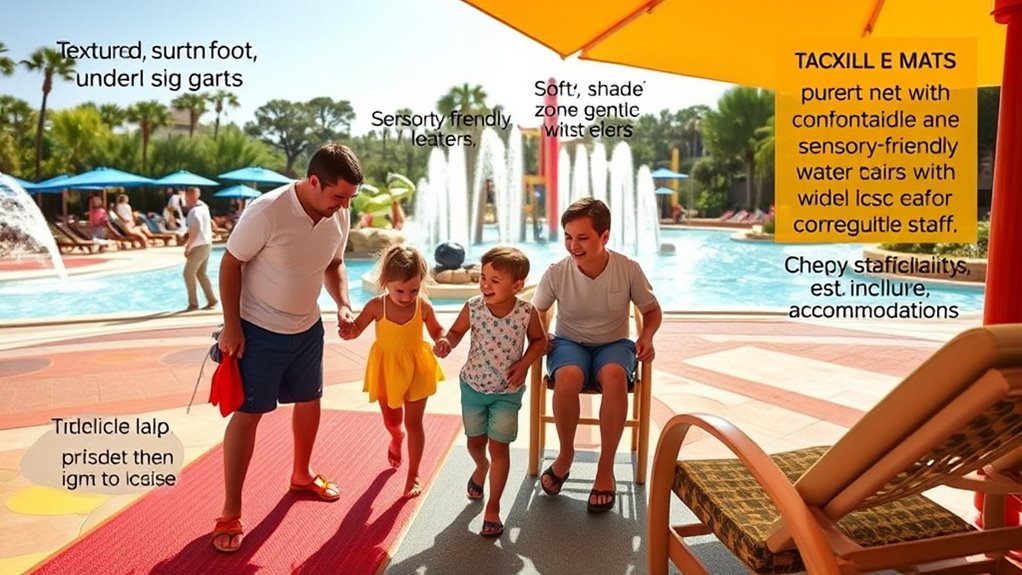
To guarantee a smooth and enjoyable visit, it’s important to plan ahead with accessibility in mind. Start by reviewing Disney’s detailed accessibility planning guides online, which cover attraction requirements and available accommodations. Make arrangements for mobility equipment rentals, such as wheelchairs or ECVs, at main entrances of water parks and other locations. Check the availability of accessible hotel rooms and communicate your needs early, including requests for portable raised toilet seats or TTY equipment if needed. Familiarize yourself with services like Rider Switch or Disability Access Service (DAS) to reduce wait times and improve your experience. Contact Disney’s accessibility experts by phone or online to tailor your visit and clarify policies, including service animal restrictions. Additionally, understanding sustainable practices in hospitality can enhance your awareness of eco-friendly options available during your trip. Proper planning guarantees a comfortable, stress-free outing.
Navigating Water Park Attractions Sensory-Sensitively
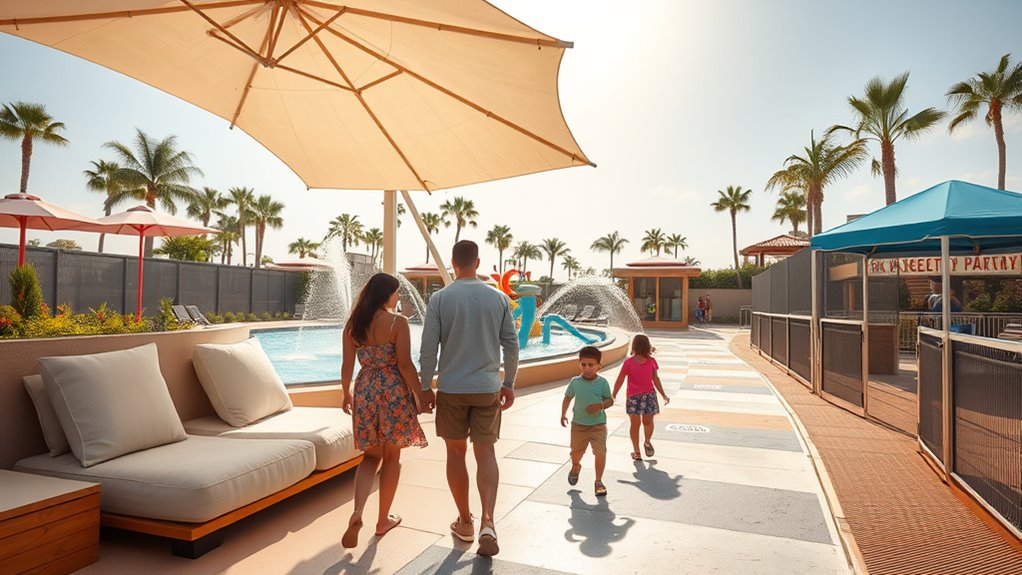
Exploring water park attractions with sensory sensitivities requires thoughtful planning and awareness of the environment. Start by choosing calmer attractions like lazy rivers, which offer predictable water movements and a soothing experience. Water play areas with gentle features can be calming and engaging without overwhelming your senses. Splash pads designed for younger children also provide a fun, low-stimulation environment. Be mindful of loud noises from water features and crowds; consider visiting during less busy times or from the sidelines. Use sensory tools like earplugs or sunglasses to reduce sensory input if needed. Communicate your needs to staff for support and explore sensory guides for each attraction to understand what to expect. Journey of Water’s calming environment and interactive water features make it an excellent choice for a sensory-friendly water park experience. Additionally, understanding data privacy challenges can help you better navigate environments that involve digital or automated systems. Taking these steps helps you navigate water park attractions comfortably and confidently.
Creating a Calm Environment With Quiet Areas and Breaks
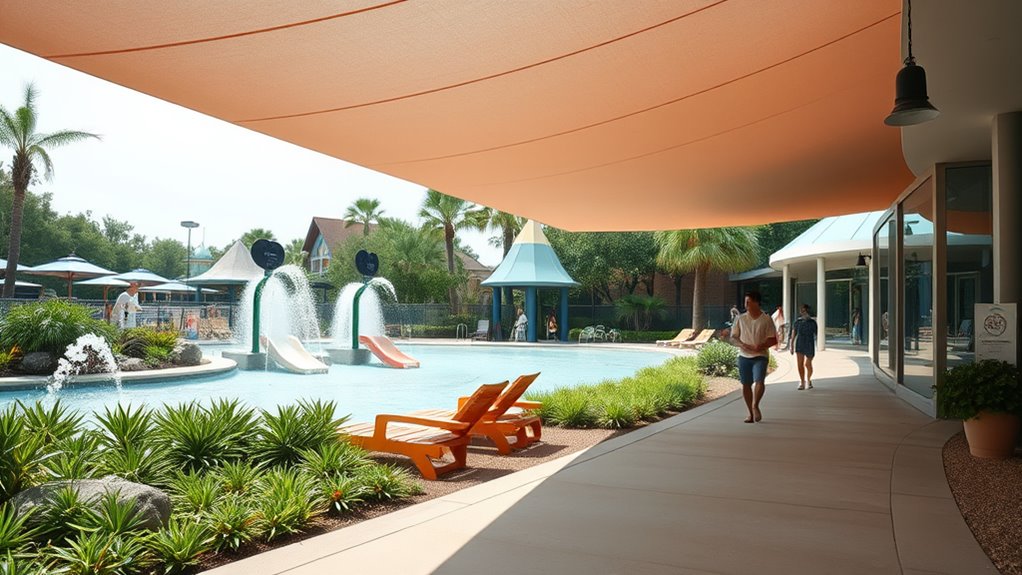
You can create a calmer environment by identifying designated quiet zones where guests can relax away from noise. Scheduling regular breaks helps prevent sensory overload and lets everyone recharge at their own pace. Clear signage and easy access make it simple for guests to find and use these calming spaces and rest periods. Implementing checklists and reviews can further ensure that these calming areas are effectively maintained and accessible for all visitors.
Designated Quiet Zones
Creating designated quiet zones in Disney water parks offers guests with sensory sensitivities an essential opportunity to take calming breaks away from the hustle and bustle. These areas are thoughtfully located near less trafficked spots, such as by ride entrances or relaxing water features. They typically include shaded seating, umbrellas, and sometimes semi-enclosed spaces to limit sensory input. You might find yourself resting on soft chairs beneath large umbrellas, surrounded by natural greenery that muffles noise. Visual screens or landscaping create physical separation from busy areas, while gentle water features provide soothing white noise. These calm environments help you decompress, reducing overload and promoting comfort throughout your visit. Incorporating safety features such as auto shut-off can also enhance comfort and security while resting in these quiet zones. Imagine sitting peacefully near a lazy river, shaded and quiet, ready for your next gentle break. Research shows that incorporating these sensory-friendly spaces can significantly enhance the overall experience for guests with sensory processing differences, making the parks more inclusive and enjoyable for everyone.
Scheduled Rest Periods
Scheduling regular sensory breaks during your water park visit helps prevent overload and keeps everyone comfortable. Plan pauses every 1-2 hours to allow guests to regulate stimuli and avoid fatigue. Use shaded seating areas or less crowded zones during peak times to reduce overstimulation. Timing breaks around meals and hydration supports overall comfort and sensory regulation. Incorporate calming auditory and visual stimuli during rest, like soothing water sounds or gentle water features, to promote relaxation without leaving the environment. Choose locations such as air-conditioned restaurants, picnic areas, or attractions with gentle motion that provide a break from intense stimuli. Keep breaks lasting 15-30 minutes to balance rest with park enjoyment. Short, frequent pauses help manage sensory needs while maintaining the flow of your visit. Additionally, selecting home theater projectors with high color accuracy and contrast can create a calming visual environment during breaks at home.
Utilizing Support Services and Accommodations
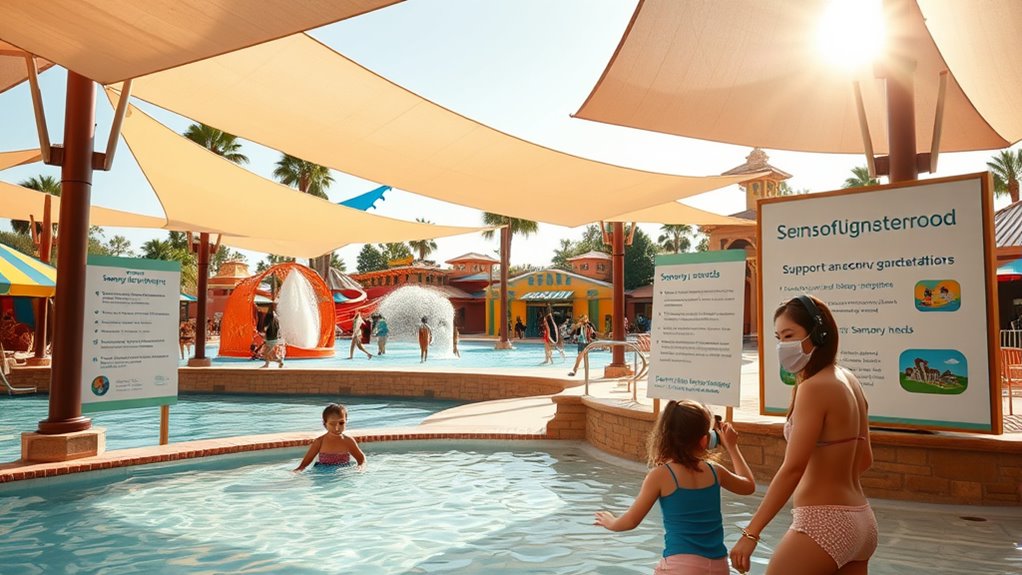
Utilizing support services and accommodations at Disney water parks can substantially enhance your visit by ensuring comfort and accessibility. You can rent mobility devices like wheelchairs and ECVs, making navigation easier. Disney provides guides and resources tailored for guests with cognitive disabilities, helping you find suitable attractions and sensory experiences. For neurodivergent guests, additional resources are available to create a comfortable environment. Family restrooms offer extra space for those needing assistance, and staff are trained to support guests with disabilities. To further improve your experience, consider these options: Many resorts also offer sensory-friendly kits and noise-canceling headphones—these can help create a calmer environment during your visit. Renting mobility devices for easy movement, accessing sensory guides for attractions, utilizing quiet spaces or designated areas, contacting Guest Services for personalized support, and planning your visit during less crowded times. Additionally, Disney staff can provide special accommodations to meet specific needs, ensuring a more enjoyable experience.
Managing Overstimulation With Sensory Tools and Strategies
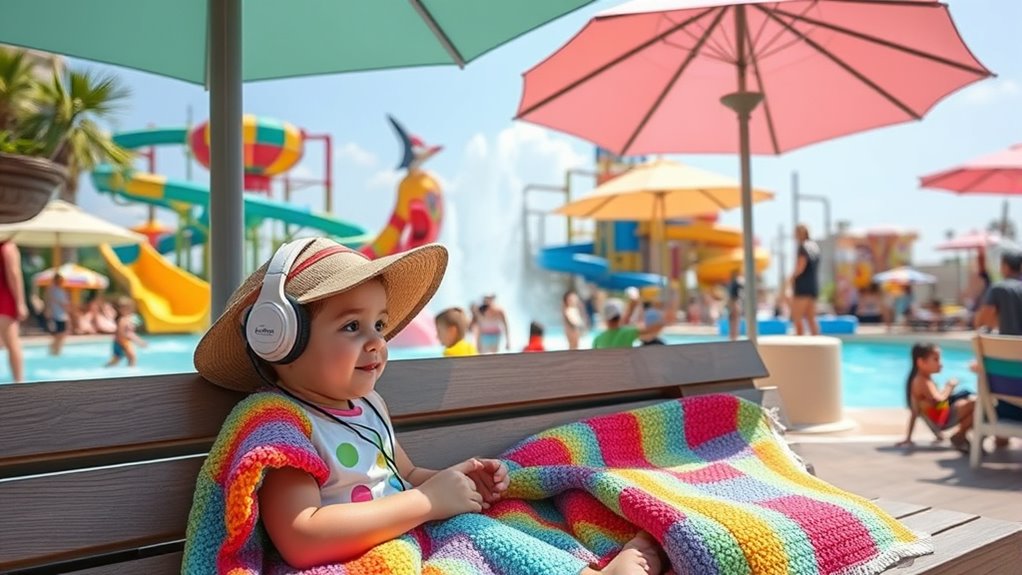
When you notice signs of sensory overload, it’s important to use calming techniques like deep pressure or focused breathing to help settle your senses. Recognizing these signs early allows you to take quick action and avoid becoming overwhelmed. You can also consider using electric bikes or other quiet, low-emission transportation options to reduce sensory input and create a calmer environment. By having strategies in place, you can better manage your experience and enjoy your visit more comfortably. Implementing sensory-friendly strategies ensures a more inclusive and enjoyable environment for all guests.
Recognize Overload Signs
Recognizing the signs of sensory overload early is essential for keeping water park visits enjoyable and safe. When someone is overwhelmed, they might show clear behavioral or physical cues indicating distress. Look for signs like covering ears to block noise, irritability, crying, or withdrawing from the crowd. Physical reactions such as flushing cheeks, rapid heartbeat, or hyperventilation can also signal overstimulation. Difficulty focusing or appearing scared might be behavioral hints, especially in children. Being attentive to these signs allows you to intervene promptly before the situation escalates. Understanding sensory processing is key to effectively managing overstimulation and ensuring comfort during water park visits.
Use Calming Techniques
Managing overstimulation at a water park becomes easier when you employ calming techniques and sensory tools designed to soothe and re-center. Use weighted lap pads or noise-canceling earmuffs to block out overwhelming sounds and provide calming sensory input. Fidgets and tactile objects keep your hands occupied, helping to reduce distress without distracting from the environment. Wearing sunglasses can lessen the impact of bright or flashing lights, while comfort items like familiar toys or textured cloths offer reassurance during sensory overload. Look for low sensory zones with dim lighting, minimal noise, and calming features like weighted blankets for quick relief. Planning quiet breaks, practicing deep breathing, or engaging in gentle water activities also help you regain calm and manage overstimulation effectively. Incorporating sensory-friendly activities can further enhance your experience and reduce discomfort during busy park days.
Resources and Tips for a Smooth, Enjoyable Experience

Planning ahead is key to guaranteeing your visit to Disney water parks is smooth and enjoyable. Utilizing resources like park maps helps you identify quieter spots and plan routes to avoid sensory overload. Disney offers accessibility services, including sensory experience guides and mobility devices, to support your needs. The cognitive disability guide provides specific attraction details, making it easier to select suitable activities. Choosing a resort with sensory-friendly amenities, such as quiet rooms and accessible spaces, enhances your stay. Taking advantage of support services and communication features ensures you’re well-prepared. Knowing the availability of sensory-friendly spaces can help you plan your day more effectively. You can also: – Locate shaded areas to escape the sun – Find air-conditioned spaces for sensory breaks – Use sensory experience details for attractions – Schedule regular breaks in quiet corners – Access guest services for personalized assistance – Consider automation’s role in business intelligence to streamline your planning and decision-making process.
Frequently Asked Questions
Are There Specific Water Attractions Suitable for Guests With Sensory Sensitivities?
You’ll find several water attractions suited for sensory sensitivities, like gentle lazy rivers and wave pools that offer calming, rhythmic water movement. Interactive play areas let you control your experience, and spots with dry pathways or misting provide options to avoid getting wet. Stick to slower rides and avoid intense slides or sudden splash effects. Nearby quiet, shaded spaces and trained staff can support your needs, ensuring a comfortable, enjoyable visit.
How Can I Identify the Quietest Times to Visit the Water Parks?
If you want to find the gentlest moments at the water parks, aim for mid-August to early October, especially on weekdays like Tuesday through Thursday. Arriving early when the parks open or visiting later in the afternoon can also help you enjoy quieter experiences. Avoid holidays and school breaks, as these times tend to bring more guests. Monitoring wait times and crowd reports can also guide you to the calmest, most relaxed visits.
What Personal Sensory Tools Are Recommended for Water Park Visits?
You should bring personal sensory tools like noise-canceling headphones to block out loud sounds, tinted swim goggles or sunglasses to reduce bright light, and handheld tactile toys or fidget objects for calming reassurance. Consider wearing a weighted vest or compression gear for added comfort and a cooling neck wrap to manage heat. These tools help you stay calm, comfortable, and enjoy the water park experience with less sensory overload.
Can I Bring Sensory-Friendly Gear or Noise-Canceling Headphones Into Water Parks?
Yes, you can bring sensory-friendly gear and noise-canceling headphones into water parks, even if it seems like a splashy challenge. Disney generally permits personal sensory items to help you stay comfortable amidst the noise and chaos. Just make certain your gear is waterproof or easy to store, and check specific park rules beforehand. So, don’t hesitate—bring your calming tools and enjoy the water park adventure on your terms!
How Do I Arrange for Additional Support or Assistance During My Visit?
You can arrange for additional support by contacting Guest Services before your visit via phone or email. They can help you register for the Disability Access Service (DAS), request sensory-friendly resources, or quiet areas. When you arrive, visit Guest Relations to discuss your needs, and trained Cast Members are available throughout the parks to provide assistance. Bringing personal sensory items or headphones is also encouraged to help create a comfortable experience.
Conclusion
By embracing these sensory-friendly tips, you’re well on your way to a more enjoyable Disney water park experience. But remember, every visit offers new surprises and challenges—are you prepared to adapt and discover the best moments yet? With a little planning and awareness, you’ll open hidden joys and create memories that last. So, stay attentive and flexible—you never know what magical, calming experience awaits just around the corner.



